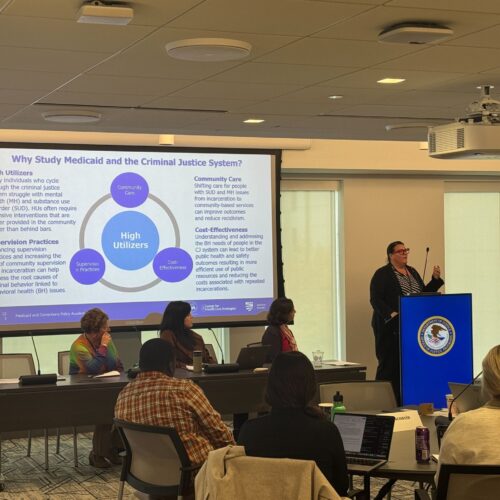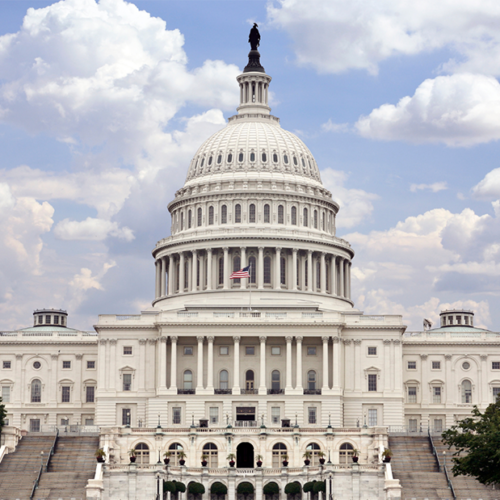
Apply Now: Medicaid and Corrections Policy Academy
The Council of State Governments (CSG) Justice Center and Center for Health Care Strategies are excited to announce a six-month Medicaid and Corrections Policy Academy on behalf of the Bureau of Justice Assistance, a component of the Department of Justice’s Office of Justice Programs. The Policy Academy will bring together teams of senior executive agency leaders from four to six states to develop multi-sector collaborative planning to leverage for improving reentry outcomes for people involved in the justice system with complex needs.
The Policy Academy is a dedicated forum and intensive training and technical assistance opportunity for policymakers leading state corrections, Medicaid, and behavioral health agencies. These cross-agency teams will work together to develop a shared vision for reentry services, build partnerships, and identify strategies to harness Medicaid (to include the Children’s Health Insurance Program (CHIP)) potential to improve access to health coverage, care, and reentry outcomes. Teams will develop action plans to address the challenges of implementing reentry best practices related to Medicaid.
Policy Academy Dates
- Optional Virtual Applicant Informational Meeting: July 17, 2024 at 2:00 p.m. ET (View the recording)
- Application Deadline: 8:00 p.m. ET on July 31, 2024 (Please note: The application deadline has been extended from July 26 to July 31.)
-
Pre-Decision Meetings with State Teams: August 6–9, 2024
-
Selection Announcement: August 22, 2024
-
Project Period: August 22, 2024–February 28, 2025
-
Virtual Kickoff Meeting (1 hour): September 10, 2024
-
In-person Policy Academy in Washington, DC (1.75 days): October 28–29, 2024
-
Virtual Peer Learning Sessions (1–2 hours): August, September, November, December 2024, January, and February 2025
-
Technical assistance calls with subject matter experts: August 2024–February 2025
- Technical assistance topics may include implementing reentry best practices such as enrollment suspension and reinstatement for Medicaid and CHIP, effecting secure linkages to community-based care, strengthening systems for information sharing, implementing medication-assisted treatment, and other approaches to closing gaps and creating pathways for Medicaid and CHIP to help fund care coordination services during reentry.
What can states expect to accomplish during the policy academy?
State teams selected to participate in the Policy Academy will do the following to develop multi-sector collaborative plans to leverage Medicaid for people involved in the justice system with complex needs:
- Identify and leverage a working group or planning body aligned with the team’s work. State teams should consider how existing statewide advisory, planning, and policymaking councils and boards can support their efforts.
- Engage as a team in pre-work with intensive one-on-one technical assistance as desired, participate in a virtual kickoff meeting, and attend an in-person two-day meeting and a series of virtual meetings.
- Develop a shared understanding of state Medicaid structure, covered services, and vehicles for care coordination as they relate to the structure for providing medical and behavioral health services in state and local corrections systems, reentry case planning, information sharing, and service delivery.
- Develop a shared vision and identify priority opportunities for partnership and policy to close gaps and use Medicaid to create funding pathways for care coordination services during reentry in areas such as stakeholder engagement, enrollment suspension and reinstatement for Medicaid, defining a priority population, screening and assessment, collaborative comprehensive case plans, medication management, ensuring connection to community-based care, strengthening systems for information sharing, and related data collection.
- Complete an action plan to identify areas of need and collaborative strategies the state can take to leverage Medicaid to improve access to evidence-based physical and behavioral health services pre- and post-release for people with mental illnesses, substance use disorders, and co-occurring chronic disorders. Examples include improving processes related to stakeholder engagement, including the voices of people with lived experience, suspending and reinstating Medicaid, defining a priority population, screening and assessment, collaborative comprehensive case management, and data and information sharing.
- Review data collection, use, and sharing practices, including the availability of current data, to inform clinical, program, and policy planning according to the characteristics and physical and behavioral health needs of affected populations, such as young adults up to age 21 and youth formerly in the foster care system up to age (see Background and Recent Federal Policy Changes to learn more).
- Receive targeted, one-on-one technical assistance from CSG Justice Center staff.
Background and Recent Federal Policy Changes
More than 6.5 million people, or approximately 1 in 38 adults, are under some form of supervision in the United States in a year, and many of them are unemployed, experience homelessness, and have complex needs. Historically, most people involved in the justice system were uninsured. People who are incarcerated are disproportionately low income and Black, Latino, and American Indian. Alaska Native individuals are disproportionately more likely to be incarcerated than White individuals. People who are incarcerated are also at much higher risk than the general population for health issues, including chronic physical illnesses, substance use disorders, and mental illnesses. Approximately 60 percent of people incarcerated in state prisons and sentenced in jails have substance use disorders.1 Approximately 37 percent of people in state and federal prisons and 44 percent of people in jails had a history of mental illness in 2011–2012.2
The transition from incarceration to the community is a very challenging period. People recently released from incarceration have much higher rates than the general population of emergency department use, overdose, and death from all causes. Effective linkage to community physical and behavioral health care services is a critical strategy for improving reentry outcomes. After the implementation of the Affordable Care Act (ACA), states that elected to expand Medicaid found that many individuals involved in the justice system were newly eligible for health coverage under Medicaid when they were released.
Recent federal policy changes, including the new Medicaid Section 1115 Reentry Demonstration and provisions in the Consolidated Appropriations Acts of 2023 and 2024, create new opportunities for state and local corrections agencies to partner with state Medicaid and CHIP agencies, other criminal justice system stakeholders, physical and behavioral health agencies, and community partners to design and implement coordinated reentry best practices, connecting people with health coverage and physical and behavioral health care services prior to release from correctional facilities.
In April 2023, the Centers for Medicare & Medicaid Services (CMS) developed guidance on a Medicaid Section 1115 Reentry Waiver Demonstration Opportunity to provide coverage for certain Medicaid services for up to 90 days before release for individuals who are incarcerated. The Medicaid Section 1115 Reentry Demonstration Opportunity focuses on improving care transitions and reentry outcomes for eligible individuals leaving correctional facilities and gives states flexibility to pilot new approaches to improve their state’s Medicaid program and better serve Medicaid-eligible individuals. States can choose which types of correctional settings to include in their demonstration, including state prisons, local jails, and youth correctional facilities. States also have the option to limit demonstration participation to specific, individual correctional facilities. States may take a phased approach to adding correctional facilities throughout the life of the proposed demonstration. The availability of Medicaid dollars means new opportunities for state and local corrections agencies to partner with state Medicaid agencies, other criminal justice system stakeholders, physical and behavioral health agencies, and community partners to design and implement coordinated reentry best practices. States may also include youth who would be otherwise eligible for CHIP as part of this demonstration opportunity.
The Consolidated Appropriations Act of 2023 makes significant changes to Medicaid and CHIP for youth and young adults involved in the justice system. The changes go into effect January 1, 2025.
- An eligible youth (or young adult) is defined to include youth in the juvenile and adult corrections systems:
- A Medicaid-eligible individual who is under 21 years of age or CHIP-eligible individual who is under 19 years of age; and
- An individual between the ages of 18 and 26 who is eligible for Medicaid under the mandatory former foster care children group.
- State Medicaid and CHIP programs are required to have a plan in place and, in accordance with such plan, provide for the following for an eligible youth who is within 30 days of their scheduled date of release following adjudication after incarceration:
- In the 30 days before release or as soon as practicable after release, screening and diagnostic services, including but not limited to behavioral health.
- In the 30 days before release and for at least 30 days after release, targeted case management services, including referrals.
- For CHIP, these requirements also apply to eligible low-income youth in states where those services are covered under the CHIP state plan.
- States may also suspend CHIP coverage during incarceration for eligible youth or continue to provide coverage for youth while they are incarcerated through CHIP. In addition, states must conduct redeterminations before release, reinstate CHIP enrollment for eligible youth upon release, and process applications and determine eligibility upon release from the public institution, similar to existing Medicaid requirements.
The Consolidated Appropriations Act of 2024 extends the requirement to suspend Medicaid coverage to both adults and youth by requiring that states suspend, not terminate, Medicaid eligibility for people who are incarcerated and ensure coverage is reactivated on release. Similarly, states may suspend rather than terminate CHIP coverage for pregnant individuals. These changes will begin in 2026. The act provides $113.5 million in funding for planning grants to states to build operational capacity for these new requirements.
What Can Teams Expect to Gain?
- Knowledge about Medicaid and corrections policy, terminology, and organizational realities in their states and recent federal policy changes and their application and relevance to different systems
- Understanding of how new opportunities available through Medicaid can help bridge gaps in coverage and care during and after incarceration
- Improved understanding of the corrections and Medicaid landscape in the state and opportunities for improved collaboration and coordination
- Dedicated time to work as a multi-sector team to develop a shared vision for bridging care and coverage gaps
- Engagement with corrections, behavioral health, and state Medicaid leaders in other states who will share emerging best practices and lessons learned and leadership from the Centers for Medicaid and Medicare Services, the Department of Justice’s Office of Justice Programs, and the Bureau of Justice Assistance
- Access to state Medicaid reentry policy subject matter experts in topical areas such as
-
- Suspension and reinstatement of Medicaid benefits;
-
- Screening and assessment for health and behavioral health needs;
-
- Identifying a priority population;
-
- Data and information sharing (ability to share clinical and demographic information; bi-directional data sharing with public health entities and community providers including, for example, necessary clinical information with Medicaid SUD treatment providers post-release; connection to health information exchanges, etc.);
-
- Data sharing infrastructure to support information sharing between state Medicaid agencies, state correctional agencies, and participating correctional facilities (for example, systems to support eligibility determinations and enrollment, including suspension strategies); and
-
- Implementing collaborative comprehensive case plans, medication-assisted treatment, and other reentry best practices
- Ongoing technical assistance from CSG Justice Center and Center for Health Care Strategies staff, including telephone consultation, facilitated conversations with other states and experts, memoranda, assessments, strategic planning discussions, presentations, and other best practices research
Who Should Apply?
State teams with limited collaborative experience between the state Medicaid authority and corrections are encouraged to apply. To be selected, teams must demonstrate that corrections, behavioral health, and state Medicaid agency leaders are willing to collaboratively develop a shared vision and lead change in their organizations to improve care and services for people leaving incarceration, ensure linkage to health coverage, and address critical infrastructure needs to improve reentry outcomes.
Application Process and Requirements
Eligibility
This opportunity is open to teams in states with limited collaborative experience between corrections and state Medicaid, including, for example, states that
- Want assistance supporting collaboration between state Medicaid and state and local corrections partners;
- Want to develop an action plan for corrections and Medicaid joint policymaking and planning;
- Are seeking to improve processes for Medicaid enrollment, suspension, and care planning as a part of reentry;
- Are considering all options for strengthening reentry best practices using Medicaid coverage, including, but not limited to, developing or revising a Medicaid Section 1115 reentry demonstration proposal or deepening partnerships;
- Are interested in implementing practice and policy changes to benefit young adults in adult correctional facilities;
- Do not have an approved Medicaid Section 1115 reentry demonstration application or pending proposal;
- Do have an existing Medicaid Section 1115 reentry demonstration application, including 1115 reentry demonstration proposals, but with limited input and involvement from corrections partners in planning and other roles as described in the State Medicaid Director Letter; and
- Do or do not have expanded Medicaid eligibility under the Affordable Care Act.
State Team Membership
- Applicants should identify teams of senior executive leaders with authority to lead pre-release services and reentry planning across systems and to engage existing coordinating bodies in the state and additional stakeholders and appropriate resources over time.
- Applications must indicate that senior executive team members are committed to building and strengthening relationships between state Medicaid and state and, if applicable, local corrections agencies during and following the Policy Academy.
- Team members must be able to dedicate the time and resources needed to participate in Policy Academy events and meetings to build sustainable cross-agency partnerships during and following the Policy Academy.
Senior Executive Leadership
State teams must identify the following senior leadership roles:
- At least one senior executive leader of the state Medicaid agency, which may include an agency director, deputy director, or chief medical officer;
- At least one senior executive leader of the state’s department of corrections, which may include a commissioner, deputy commissioner, or medical director; and
- At least one senior executive leader of the state behavioral health authority, which may include an executive director, agency director, deputy director, or medical director.
Team Lead
In addition to senior executive leaders, each team should identify a team lead with appropriate project management skills to serve as the central point of contact to ensure accountability for all team members. Team leads will participate in all in-person and virtual Policy Academy meetings and ensure appropriate leadership and support role participation throughout the six-month Medicaid and Corrections Policy Academy. The team lead ideally will provide ongoing leadership or serve as the designated agency coordinator as collaboration and planning continue after the Policy Academy ends.
Additional Team Members
- We encourage state teams to identify other stakeholders who will be important in developing sustainable cross-system communication and collaboration, such as community-based health care providers, correctional health care providers, local corrections officials, county commissioners, reentry providers, community corrections, and community-based organizations. Teams may indicate stakeholders they intend to add over time as part of the action plan.
- We encourage states to use existing committees to support this work, such as statewide Reentry Councils, Behavioral Health and Criminal Justice Committees, and other similar cross-system groups that may already exist.
Participation Requirements
- Pre-decision meeting with state teams (August 6–9). State teams will be asked to participate in a 30-minute discussion with CSG Justice Center staff. These discussions will be used to understand the rationale for the team’s composition, objectives and challenges, and how team members will participate. All senior executive leaders for selected teams should participate in the pre-decision meeting with state teams.
- Virtual kickoff meeting (September 10). Senior executive team members and the team leader must attend the virtual kickoff meeting. Additional team members are welcome to attend.
- In-person Policy Academy (October 28–29). Team leads and senior executive leader team members from corrections and state Medicaid and behavioral health authorities must attend the Medicaid and Corrections Policy Academy. Up to five state team members may participate. The Policy Academy will pay for travel and hotel expenses for up to five team members.
- Virtual monthly follow-up meetings (August 2024–February 2025). Virtual follow-up meetings (1–2 hours) will provide tailored technical assistance and support for action planning. Team leads should attend the virtual follow-up meetings; ensure participation by appropriate team members across systems, organizations, and agencies; and coordinate follow-up and communications afterward with all team members. State teams will be able to share learnings with each other and the field through a panel discussion or webinar.
- Technical assistance calls (August–February). State teams will have access to technical assistance from subject matter experts on reentry best practice topics and processes. Team leads will be central points of contact with Policy Academy staff; ensure appropriate team members are included across systems, organizations, and agencies; and manage communication and follow-up with team members.
Application Selection Criteria
Applications will be scored according to the following criteria:
| SELECTION CRITERIA | WEIGHT |
| Appropriate state-level senior leadership sponsorship able to secure needed resources and lead change during and following the Policy Academy | 40% |
| Additional team members identified to support effective engagement, participation, and action within and across agencies | 15% |
| Limited or no history of collaboration between corrections and state Medicaid | 15% |
| Identification of key challenges (e.g., care management, data use and sharing) | 15% |
| Identification of appropriate objectives for participating | 15% |
How to Apply
Teams interested in applying should complete this application by 8:00 p.m. ET on Wednesday, July 31, 2024. (Please note: The application deadline has been extended from July 26 to July 31.) If you have any questions, please contact Tiffany McKnight at tmcknight@csg.org.
Endnotes
1. Jennifer Bronson et al., Drug Use, Dependence, and Abuse Among State Prisoners and Jail Inmates, 2007-2009 (Washington, DC: Bureau of Justice Statistics, 2010); Danielle Kaeble and Mary Cowhig, Correctional Populations in the United States, 2016 (Washington, DC: Bureau of Justice Statistics, 2018), https://bjs.ojp.gov/content/pub/pdf/cpus16.pdf.
2. Centers for Medicare and Medicaid Services, State Medicaid Director Letter #23-003, Opportunities to Test Transition-Related Strategies to Support Community Reentry and Improve Care Transitions for Individuals Who Are Incarcerated (Baltimore: U.S. Department of Health and Human Services, 2023), https://www.medicaid.gov/sites/default/files/2023-04/smd23003.pdf.
Photo via Canva.

This project was supported by Grant No. 15PBJA-23-GK-05504-MUMU awarded by the Bureau of Justice Assistance. The Bureau of Justice Assistance is a component of the Department of Justice’s Office of Justice Programs, which also includes the Bureau of Justice Statistics, the National Institute of Justice, the Office of Juvenile Justice and Delinquency Prevention, the Office for Victims of Crime, and the Office of Sex Offender Sentencing, Monitoring, Apprehending, Registering, and Tracking. Points of view or opinions in this document are those of the author and do not necessarily represent the official position or policies of the U.S. Department of Justice.
About the author

When returning to their communities from criminal justice settings, people with behavioral health needs face barriers in accessing…
Read MoreNew Hampshire Department of Corrections Commissioner Helen Hanks presents at the Medicaid and Corrections Policy Academy in-person meeting.
Read MoreThe Council of State Governments (CSG) Justice Center has launched the Collaborating for Youth and Public Safety Initiative…
Read More Assigned to the Cloud Crew: The National Incarceration Association’s Hybrid Case Management for People with Behavioral Health Needs
Assigned to the Cloud Crew: The National Incarceration Association’s Hybrid Case Management for People with Behavioral Health Needs
When returning to their communities from criminal justice settings, people with behavioral health needs face barriers in accessing basic needs—including food, housing, employment, transportation, education, clothing, and substance use and mental health services—which increases their risk of experiencing a crisis.
Read More Meet the Medicaid and Corrections Policy Academy Mentor States
Meet the Medicaid and Corrections Policy Academy Mentor States
New Hampshire Department of Corrections Commissioner Helen Hanks presents at the Medicaid and Corrections Policy Academy in-person meeting.
Read More Six States Commit to Improving Statewide Strategies to Address Youth Crime, Violence and Behavioral Health
Six States Commit to Improving Statewide Strategies to Address Youth Crime, Violence and Behavioral Health
The Council of State Governments (CSG) Justice Center has launched the Collaborating for Youth and Public Safety Initiative (CYPSI) in partnership with six states: California, New Mexico, New York, Ohio, Oklahoma, and Rhode Island. The initiative will help states develop, fund, and effectively implement a research-based service continuum to improve public safety and behavioral health, education, and other outcomes for youth.
Read More Bipartisan Group of 88 Lawmakers Push for Continued Funding for Reentry and Recidivism Programs
Bipartisan Group of 88 Lawmakers Push for Continued Funding for Reentry and Recidivism Programs
A bipartisan group of 88 lawmakers, led by Representatives Carol Miller (R-WV) and Danny Davis (D-IL), wrote a letter calling for continued funding for the Second Chance Act in the Fiscal Year 2026 Commerce, Justice, Science, and Related Agencies appropriations bill.
Read More









